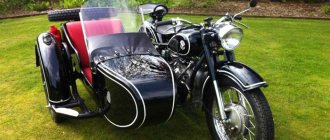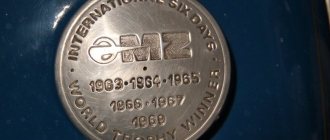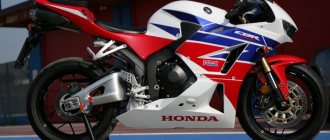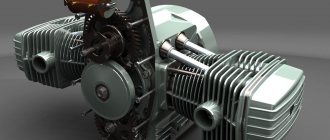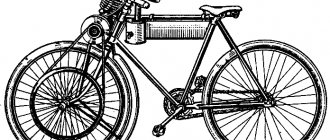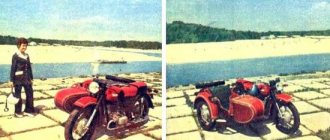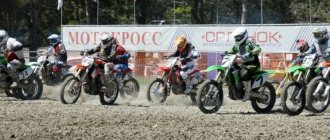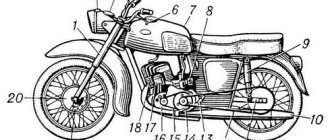This year marks the 135th anniversary of the world's first motorcycle. Its creators were German engineers Daimler and Maybach, who later became the founders of famous automobile brands. The first domestic motorcycle was developed and put into production at , which was succeeded years later by JSC UEC-Klimov.
The L-300 became legendary in its own way - it drove along the roads of the Great Patriotic War, opened motorsports to many, and took part in record-breaking races. “Oktyabryat”, as the L-300 is often called, has little left to our time. One of the cars has been preserved for history and is an exhibit of the UEC-Klimov museum.
History of the motorcycle. Invention
The bicycle is the predecessor of the motorcycle. The similarity between a bicycle and a motorcycle is obvious to everyone, and it is also completely clear that the first preceded the second. But where did the bicycle come from? The original idea was a two-wheeled device that needed to be ridden, allowing relatively high speeds without the need for a horse or train. Karl von Dres invented the bicycle in 1817. However, other inventors copied and improved his design. Von Dres himself called his device a laufmachine (from German - a running machine), others also called it a Dres machine, a scooter, a pedestrian chair and a bicycle. Unfortunately, we don’t know who came up with the idea of installing pedals on a bicycle. One thing is certain: it took several decades. The first pedal bicycle was patented in 1866, although in some parts of the world it had been available for several years before that. The term "bicycle" was coined in the 1860s. It was during this time and subsequent decades that bicycles gained popularity.
running machine
First motorcycle
There is no clear answer as to who invented the first motorcycle because there is no consensus on the definition of a motorcycle. Does it have to be equipped with an internal combustion engine? Is it necessary to have no pedals? Should the number of wheels be limited to two? But even if we omit the exact definition, it is clear to everyone that the first self-propelled bicycles were powered by steam. They appeared in the late 1860s. Mention of the first steam bicycles could be found in American newspapers in 1869.
First motorcycle (self-propelled bicycle)
The first copies of motorcycles are associated with the names of Sylvester Roper and Ernest Michaud. Although it is not possible to find out which of them was the first, it is absolutely certain that both of them, independently of each other, created the first motorcycle at approximately the same time (in 1867 or 1868). In 1885, the internal combustion engine was installed in the riding cart (prototype motorcycle) of Gottlieb Daimler and Wilhelm Maybach. This vehicle went down in the history of motorcycle manufacturing as the first predecessor of modern motorcycles. But the inventors were interested not so much in the machine as such, but in the possibility of using and applicability of the engine.
Can Daimler's carriage be considered the first motorcycle? If you strictly rely on the definition, then no. Technically, it was not a two-wheeled vehicle because it was equipped with side assistance wheels. And yet, according to many definitions, it was the first motorcycle, because it combined two main conditions: a basic design and an internal combustion engine. No one had done this before; the internal combustion engine became an integral part of the motorcycle for the next hundred years.
AWD Motorcycles. Beginning of the 20th century.
Mar 29 • All-terrain vehicles in Russia, All-terrain vehicles Photos, Foreign All-terrain vehicles, All-terrain vehicles, On wheels, All-terrain vehicle manufacturers, Sports and Recreation • • Comments on the entry AWD Motorcycles.
Beginning of the 20th century. disabled In the photo above: Monument to the 130th anniversary of the First Russian and Soviet Engineer - creator of domestic motorcycles, Pyotr Vladimirovich Mozharov, on the square in front of the Izhevsk Motor Plant
Series of articles “Legends of World Motorcycle Culture”, AWD motorcycles, 3x2, 2x2
The idea of a 2x2 drive has not left the minds of engineers and “Kulibins” all over the world since the appearance of the motorcycle as such.
Russia is full of home-made products, and not quite home-made products, that in Russia, all over the world, engineers are experimenting with this idea...
The main and oldest player in the all-wheel drive two-wheel drive market remains the American company Rokon, which has been producing 2WD motorcycles virtually unchanged since 1960.
We also found the first prototypes of AWD iron horses in the American Patent Office.
Motorcycle or motorcycle
The motorcycle became a practical vehicle thanks to many other inventions and devices. One of the most important components was the internal combustion engine, but mass production of serial motorcycles began only after the creation of pneumatic tires, chain drive and the invention of the modern form of the bicycle. Daimler and Maybach did not pursue the goal of practical use of their car, but others were able to consider this possibility. Various motor companies began selling kits with motors that could be mounted on bicycles. Soon, motorized bicycles ceased to be outlandish exhibits at fairs; people actively used them for transportation. And, of course, the term “motorized bicycle” was soon shortened to “motorcycle.” In some cases, the variant "motorcycle" was also used, then the version with the letter P began to be considered a spelling error.
If bikes and engine kits were in high demand, why not sell them together? It was this idea that the brothers Heinrich, Wilhelm Hildebrand and Alois Wolfmüller came to. They registered their patent in 1894, the same year the first retail motorcycle appeared on the market: Hildebrand & Wolfmüller.
First retail motorcycle: Hildebrand & Wolfmüller
Colonel Holden's 1896 four-cylinder motorcycle.
The motorcycle, branded “Hildebrand und Wolfmüller,” had a horizontal two-cylinder four-stroke engine located in the lower part of a special frame made of metal pipes. The intake valves were automatic, the exhaust valves were driven by cams located directly on the rear wheel. The drive to the rear wheel was direct - the connecting rods were attached to the wheel. Thus, the wheel also served as a flywheel, and in order for the piston to more confidently overcome dead spots, rubber rods were introduced into the design. The gas tank also served as an evaporative carburetor, the cooling was liquid, and the coolant reservoir was again the rear wheel. Ignition is by a glow plug in the cylinder head. The engine displacement was 1490 cm3, the maximum power was 2.5 liters. s, at 240 rpm. A motorcycle weighing 60 kg could be accelerated by such an engine to a speed of 40 km/h.
Wave of the future
On December 7, 1895, an article in an American scientific journal predicted that motorcycles would occupy an important place in people's lives in the very near future.
Without a doubt, the motorcycle came into our lives to stay. Compared to a horse-drawn carriage, it has certain advantages. We think that this vehicle is destined to play an important role in urban traffic. Already today, the main transport arteries of large cities are heavily overloaded. Using motorcycles will help a lot in this. If thousands of horses are removed from city streets, sanitary conditions will improve significantly. And this, in turn, will have a positive impact on the health of all people.
Early history of the motorcycle. Racing
At one time, bicycle racing was very popular. So it is not surprising that motorcycle racing has gained no less popularity. For example, Indian was founded by two bicycle racers. In no time at all, the company has made a name for itself for its commitment to racing. Other motorcycle manufacturers began to follow this formula.
Prototype of the first Harley Davidson motorcycle
For example, the prototype of the first Harley Davidson motorcycle first took part in races, and only then went on mass sale. By the 1910s, many racers and manufacturers had become bitter enemies. The passion for racing became the catalyst for the development of the motorcycle industry, and it did not take long for the world of motorcycles and the world of bicycles to finally separate. Now motorcycles are no longer just bicycles with motors. They became machines in a unique class. To develop high speed, they began to create not only motorcycles, but also special tracks. This is how racing in a circle on wooden stages arose. Fortunately, other motorcycle disciplines soon emerged, but they all date back to the early days of motorcycle racing history.
Motorcycle Society
The motorcycle community was growing and government agencies couldn't stay away. As a result, the International Motorcycle Organization FIM (Fédération Internationale de Motocyclisme) was organized. It all started in 1904 with a small club. A couple of decades later, in 1924, the American Motorcyclist Association AMA (American Motorcyclist Association) was founded.
By the 1910s, motorcycles were firmly established in people's daily lives. Companies that ten years ago produced only a few hundred motorcycles a year were now producing thousands. The intended buyers were young men. They were suitable for several reasons. Firstly, they are more courageous and desperate. Secondly, they could not afford expensive cars. And, finally, they did not have time to acquire families that would need to be transported somewhere. Motorcycles were used not only as a means of transportation, but also for entertainment. For over a century, recreational motorcycling has remained an important aspect of the industry.
Thanks to their low price, speed and practicality, motorcycles have penetrated many areas of people's daily lives. For example, motorcycles began to be used in delivery: mail, groceries, etc. Some motorcycles were even designed specifically for these purposes. At the same time, motorcycles with sidecars began to gain popularity. They allowed the motorcyclist to take a passenger with him and carry him on the side on a separate seat.
Motorcycles at war
With the outbreak of World War I in 1914, motorcycles gained another function. They were perfectly suited for conveying messages. But that was not all. Machine guns were installed on motorcycles. Very quickly, motorcycles became an important part of the war effort. Tens of thousands of motorcycles were used in World War I. Captain Louis Keane, an English officer, explained the role of motorcycles at a critical time:
Motorcycles in war are not a circus or a carnival, it’s a business, a bloody business.
Henry Wali motorcycle with air engine, 1894.
The two- and three-wheeled motorcycles created by the Frenchman Felix Millet had a very original design. He built his first machine in 1892, and its most remarkable feature was its star-shaped five-cylinder rotary (that is, the cylinders rotated, but the crankshaft remained stationary) engine. Such engines, very popular in aviation during the First World War (the famous “Gnome-Ron”), were patented by Millet back in 1887. The cylinders were connected to a special ring attached to the wheel rim with spring rings or braces. At 180 rpm the engine developed a power of 2 hp. With. The first car, in 1892, was three-wheeled, and the engine-wheel unit was installed at the front. On the two-wheeled version of 1893, the engine was located in the rear wheel.
History of the motorcycle. Dominant brands
By the end of the war, the army's need for motorcycles had dropped, and demand among ordinary people had increased markedly... until the Great Depression began in 1929. Motorcycle manufacturers have had to make some tough decisions. When the motorcycle industry first began, there were dozens, if not hundreds, of companies that made motorcycles. In those days, when the only thing required was to install an engine on a bicycle, this was possible. However, after motorcycles have been around for decades, they have gained certain features and only a few brands have come to dominate the market. The Great Depression “ate” the rest; not even all the strong producers were able to survive. Harley Davidson, Indian and Excelsior became America's largest motorcycle manufacturers. Excelsior's owner, Ignaz Schwinn, stopped assembling Excelsior-Henderson motorcycles in 1931 to concentrate on bicycle production. This strategy was chosen in order to survive depression. Harley Davidson and Indian continued to produce motorcycles, although volumes had to be reduced significantly.
Despite all the difficulties, many motorcycle manufacturers with names that are still well known today continued to operate, including Excelsior (United Kingdom, not to be confused with the American company of the same name), Triumph (United Kingdom), Royal Enfield (United Kingdom), BMW (Germany). ), Husqvarna (Sweden), Ducati (Italy), Moto Guzzi (Italy). All of these manufacturers adhere to covenants that are still of great importance today. In addition, strong bonds have been formed within the motorcycle community.
Road
Road or universal bikes that are suitable for riding around the city and covering short distances on the highway. It was with these motorcycles that the story began. The “fathers” of modern models are still very popular and are on par with cars.
It should be noted that calling a particular motorcycle “road” or “classic” is a rather “slippery” topic. For example, the BMW company introduced the term “roadster” into the designation of its road motorcycle models (we’ll talk about it later). Despite the fact that we are talking about purely automotive topics, for several years now many specialized publications have been willingly and boldly using this designation.
Standard
The classic motorcycle or "standard" appeared before the classic car with an internal combustion engine - back in 1886. Until now, it is classified as a vehicle “for every day”.
Classic motorcycles have a special magic; they make their owner fall in love with their grace and at the same time brutality. A motorcycle with a direct pilot seat (saddle height no lower than 85 cm) and a minimum of plastic. A classic bike is usually equipped with a small number of external body kits, but is equipped with lighting equipment - you can really safely move on it on dark public roads.
All types of such road motorcycles:
- equipped with a powerful engine and modernized transmission - suitable for daily driving on city streets;
- have the same size rear and front wheels - this feature makes it easier to move on an asphalt road;
- They are distinguished by universal rubber - the combined tread is suitable for traction on any type of road.
Honda CB750
An example of a legendary classic model is the Honda CB750 motorcycle from 1969 from the Land of the Rising Sun. At the time of release, this samurai was able to revolutionize the market by introducing 4-cylinder engines, which confidently replaced the 2-cylinder engine that was popular at that time.
Road retro motorcycles from the 60s and 80s are still popular today. Despite its age, the value of such technology is only growing.
Naked
Naked or “naked” is a type of passenger motorcycle for a beginner. This bike is devoid of fairings, which in classic models traditionally cover the engine and frame. The model was created for a typical city dweller who appreciates the maneuverability of equipment - you can easily drive this motorcycle even through narrow passages.
Among the characteristic features of Naked it is also worth noting:
- free access to engine repair work and other basic elements;
- comfortable slightly inclined position of the driver on the seat;
- low speed - you won’t accelerate much on “naked” models.
If we compare the appearance of the motorcycle and its “filling”, we can confidently classify naked bikes as affordable models. The excellent price of motorcycles is due to minimalism in tuning - the costs of the production process spontaneously decrease.
Bobber
It is not difficult to guess what class this motorcycle belongs to. The bobber is a typical road bike. This special type of motorcycle began to appear in the 30s and 40s of the 20th century in the USA. At that time, motorcycle racing on a dirt track was popular. Along with the Harley, the bobber, as a class of motorcycle, has become a cult favorite for many generations of motorcycle connoisseurs.
The “trick” of this model is its simplicity. The seats, headlights, battery and gas tank have all been replaced with lighter counterparts. The essence of this tuning was to reduce the weight of the motorcycle without changing the technical and running parameters.
Over time, the bobber changed, and in the end it became an exclusively sporting attribute. The modernizations turned out to be so successful that for a long time in America bobbers were at the peak of popularity even after the advent of good roads.
The modern bobber has lost some of its charm. Today, a model may have an unusually high fork and a bulky, disproportionate muffler. A bobber in the 21st century is more pathos than practicality.
We'll bring a motorcycle from the Japanese auction!
Request a call
Roadster
Roadsters combine the chassis geometry of classic bikes with high-torque two- or four-cylinder engines. The seat height of the new type of motorcycle does not exceed 65 cm - you can sit in it not only upright, but also quite low, which increases the level of comfort over long distances.
Roadsters were created for high elasticity and dynamic power development. The model has a low curb weight: the engine chassis, frame and windshield are not covered. Since there is no skin, you won’t be able to drive at a constant speed of 160 km/h on a roadster.
The mixture of a bike and a car quickly became popular. There are three explanations for this - an unusual design that attracts attention on the road, good technical solutions, as well as a desire to demonstrate one’s wealth - such a “toy” costs quite a lot.
Cafe racer
This motorcycle is worth choosing if you plan to regularly ride at high speed over short distances. Cafe racers began to be mass-produced in the United States in 1901. The first cafe racer was created on the basis of the British Triumph Bonneville. This model is still produced, only its stylistic design changes.
The basic advantages of the technology are rapidly developing speed and excellent controllability. However, when choosing such an “iron horse”, you should immediately prepare for a minimum of comfort.
The term "cafe racer" originated in England in the 1960s as an ironic name for motorcyclists who pretended to be "cool" professional racers by parking their vehicles next to a table in a cafe.
Scrambler
One of the most extraordinary types of classic motorcycles is the dual-purpose bike. The scrambler is a stylization of retro technology. It is quite well equipped and was designed for light off-road driving.
Classic road models began to be converted into scramblers. Motorcycles were made easy and motivating. Today, such a motorcycle is not easy to find: they are practically not produced, because they consider the production of “exotic” to be an unprofitable activity.
Ducati Scrambler
The popular company Ducati nevertheless released its Scrambler, and later British manufacturers also caught up. The released bikes fully correspond to their name, however, the list of production motorcycles is still very short.
Oil bike
Stunning power and beauty in metal. This is a laconic, classic-style roadster. Of all types of road motorcycles, it is one of the fastest. On such a bike you can easily win the “traffic light race”. However, it is worth considering that these motorcycles are not inclined to turns and sudden braking.
Yamaha V-Max
It is due to the features of this model that the legendary Yamaha V-Max received the symbolic name “Sledgehammer”.
Before buying an oil bike, you should “try it on for yourself” - sit on it, feel the power and heaviness of the equipment.
https://jplife.ru/statistic/YAMAHA/OTHER/?
Cruiser
Cruisers “changed clothes” from touring motorcycles and immediately became the standard of style. The first cruiser model appeared in the USA in the 40-50s. 20th century, when fans demanded chic and brutality.
Among the characteristic features of such a representative it is worth highlighting:
- complete absence of plastic and abundance of chrome;
- seat height no higher than 75 cm, comfortable saddle, high back;
- U-shaped handlebar, forward-mounted footrest;
- two-cylinder engine, teardrop-shaped tank.
In general, the manufacturers managed to create a motorcycle that gives the feeling of riding not on an open bike, but on a luxury car. Below is a little more detail about what types of such motorcycles there are.
Chopper
The “trick” of American choppers is their expressive appearance. These are not the fastest motorcycles, but they are successfully styled to suit the owner. The main features by which you recognize a chopper: an elongated front fork, a wide rear wheel, a teardrop-shaped tank, a two-level seat and a high steering wheel, as well as leather and chrome in the design.
Power cruiser
He's a dragster. A motorcycle “tailored” for powerful grips especially for those who like cruisers, but don’t like their calm disposition. It's a motorcycle shaped around a motor. If you want pure power with sporty dynamics and a comfortable riding position, there's no better option.
Sports
Motorsports competitions were first organized in 1894. It was from this period that the classification of motorcycles into “civilian” and “sports” or “racing” appeared.
It’s worth noting right away that such bikes are designed for victory, and not for comfort, so riding them is not very comfortable. The driver has to curl up on the saddle or even lie on his stomach. Therefore, if you need a bike for everyday driving on city roads, this is not your option.
The maximum speed that this “beast” develops is 290-300 km/h. The number of engine revolutions is more than 10 thousand.
Streetfighter
This is a class of road motorcycles - the same as a sportbike, however, it is more suitable for city riding. The motorcycle is characterized by high maneuverability, excellent handling, and stability on the trajectory. Victory in the case of this model is not at the forefront. Streetfighter will appeal to those who have wanted change for a very long time, but at the same time are attached to the urban area.
Tourist
Tourers or “limousines” are very comfortable and cost much more than standard ones. Such models appeared to the world relatively recently - as soon as amateurs began to be interested in comfortable motorcycles with many functions.
Ideal transport for tourist trips. Manufacturers of trainers, full trainers, and baggers focus on comfort and safety, de-emphasizing speed and maneuverability. On such a bike you can comfortably ride up to 1000 km per day. Among the distinctive features of motorcycles, it is worth noting a high back, a soft seat, trunks on the sides, and a luggage compartment. Some models are equipped with cruise control, radio, air conditioning, airbags, and a passenger seat.
Sports and tourism
“Sport-tourist” motorcycles are sporty in appearance, but intended for long-distance travel. Such models became popular in the 80-90s of the last century. According to owners' reviews, a sports touring bike should be appreciated for its aggressive design, technology and high speed.
History of the motorcycle. Rally
Many motorcyclists gathered to ride together and participate in races and stunt shows. Riders often gathered outside the city in tent camps or hotels. At first, such gatherings of motorcyclists were called “gypsy tours.” Today such meetings are called rallies or rallies. Some of today's most popular rallies have their roots in those difficult times, such as Daytona Beach Bike Week (1937) and Sturgis Motorcycle Rally (1938). And some began even earlier, such as Laconia Motorcycle Week (1916).
Motorcycles during World War II
World War II began in 1939 and ended the Great Depression. This situation benefited the motorcycle industry, but it was not the only effect. Army demand for motorcycles increased production volumes significantly. Those companies that were able to survive the difficult times were now at full capacity. One such company is Harley Davidson, which produced about 100,000 military motorcycles during this time. Most of them belonged to the WLA line, where the letter A stood for Army. Even though Jeeps have taken on an important role as military vehicles, motorcycles have not given up their place. Motorcycles made it possible to move quickly, and they could also go where larger vehicles had difficulty. WLA motorcycles could be equipped with guns, but they were nevertheless used more for reconnaissance and the transmission of dispatches.
Motorcycles during World War II
By the end of the war, Harley Davidson was stronger than ever. The other major American company of the time, Indian, did not have such lucrative contracts. It was partly for this reason that the company ceased to exist in 1953 and sold the name to the English company Royal Enfield. The United States was far from the only country that actively used motorcycles during World War II. Each of the countries participating in the hostilities used their own production: Great Britain—Royal Enfield, Norton and BSA, Germany—BMW and Zündapp, CCCP—Ural, Italy—Moto Guzzi, Japan—Rikuo. And these are just a few examples. There were certain differences between motorcycles from different brands, but the technical staff did not keep the features of their machines a secret. For example, the Harley Davidson line had a shaft-drive prototype (HD XA) that resembled the design of the BMW R75.
BMW R75
Along military paths into motorsports
The L-300 motorcycle was produced until the end of 1939 - in total, about 19 thousand motorcycles of this model were manufactured. And even when by 1940 their design was already “morally” outdated, and Izhevsk “motor legends” came to replace them, Leningrad L-300s were still in demand due to their high reliability and ease of control. This was proven in practice - the L-300 was actively used in the Red Army as reconnaissance and communications motorcycles. They took part in the battles at Khalkhin Gol and Khasan, in the Soviet-Finnish War and at the beginning of the Great Patriotic War.
The L-300 also took an active part in the development of domestic motorsports - it was widely used in races, cross-country races, record races and long-distance runs of thousands of kilometers. At competitions, the L-300 often won prizes in competition with famous foreign motorcycles.
Photo: Military Technical Museum
And, perhaps most importantly, the L-300 provided thousands of Soviet people with the opportunity to ride a motorcycle for the first time. At the same time, the experience of organizing serial production of the L-300 helped in the production of domestic motorcycles of new generations. This is how the first Soviet sports road motorcycle L-500 appeared, followed by the L-8 with many racing modifications and a speed of about 140 km/h. The legendary Izhevsk motorcycles Izh-7 and Izh-8 also became “descendants” of the L-300. The latter is considered a real Soviet legendary bike, and also gained fame abroad. The Izh-8 motorcycle is even stamped on New Zealand silver coins.
In addition to Izhevsk, serial production of motorcycles was established in Podolsk, Taganrog, and Serpukhov. But still, Leningrad and the L-300 model were the first. Today this motorcycle can no longer be seen on the roads, but can be seen in the museum. One of the copies of this model is exhibited in the museum of JSC "ODK-Klimov".
History of the motorcycle. At the peak of popularity
After the war, veterans returned home and were surprised to find that the country had changed a lot, both economically and socially. It was not easy for them to adapt to civilian life. For some, it was too monotonous after the fury of war. It was difficult for some to have serious relationships with people outside the same military community. Some had to cope with post-traumatic disorder. But regardless of the real reasons, many of these veterans have found solace and a solution to their problems in motorcycles. As a result, there are more people riding motorcycles than ever before. Modern biker culture grew from here. A new generation of motorcyclists emerged who were strikingly different from their predecessors. Organizations that were called outlaw motorcycle clubs grew like mushrooms after rain. The word "outlaw" means that these clubs are not approved by the AMA; there is no criminal element to the term. Bikers from different clubs were distinguished from each other by stripes with different logos, colors and slogans. These distinctive signs originate in military culture. Many outlaw motorcycle clubs used them, but they did not mean anything criminal. However, some motorcycle clubs were not so innocent, on the contrary: they created a reputation for themselves as rebels. They called themselves one percenters (as opposed to the 99% of motorcyclists who belonged to legitimate clubs). This is how criminal biker gangs began to emerge. Many of these terms and principles, outlaw motorcycle clubs, stripes, one percenters, are still used today.
To be continued: AWD Motorcycles “Everything for the front! Everything for victory!
March 2021. Evgeny Ageev for News 94
AWD MOTORCYCLES EARLY 20TH CENTURY Ural AWD 3x3 principle
AWD MOTORCYCLES OF THE BEGINNING OF THE 20TH CENTURY Ural AWD 3x3 from Kovrovsky Palych
AWD MOTORCYCLES EARLY 20TH CENTURY Ural AWD 3x3 high quality
AWD MOTORCYCLES EARLY 20TH CENTURY Ural AWD 3x3 visible drive
AWD MOTORCYCLES OF THE EARLY 20TH CENTURY All-wheel drive Ural Samodelkina
AmericaHistoryMotorcycleRussia
Related Posts
- Oct 6 •
Chrysler snowmobile
- Apr 13 •
AWD Motorcycles. ROKON Trail-Breaker working donkey for farmer and soldier. Grandfather celebrated his 60th birthday
- Apr 9 •
AWD Motorcycles. Christini 450AWD - All Wheel Drive Explained
- Apr 5 •
AWD Motorcycles. By the end of the twentieth century, they begin to emerge.
- Mar 31 •
AWD Motorcycles. “Everything for the front! Everything for victory!
- Mar 16 •
The world's first surviving four-wheel drive motorcycle
- Mar 12 •
The birth of four-wheel drive
- Aug 18 •
“The Dnieper is wonderful in calm weather...”
- Aug 16 •
Review of the new Chevrolet Colorado ZR2 2020
- Mar 25 •
For tourists
- Mar 15 •
Ale-gator. UTV amphibious
- Mar 11 •
Earth and Wind - a luxurious refuge
- Mar 11 •
Ford Excursion - Amphibian
- Mar 4 •
And again Hydra
- Feb 26 •
Cognac, performance and herd of 800 horses
- Feb 25 •
Panther is not afraid of water
- Feb 22 •
Amphicar 770 stayed in the 60s
- Feb 21 •
Tundra and Arctic territory of all-terrain vehicles
- Feb 15 •
English Budulai. Episodes 2 and 4
- Feb 14 •
English Budulai. 1st Series
- Feb 12 •
DEATH CAPSULE
- Feb 11 •
Aquda Gibbs - the first prototype of a high-speed amphibian
- Feb 8 •
Water tested. Military amphibians, development, new items
- Feb 6 •
Humdinga and Aquada will be in Doha
- Feb 4 •
BISKI amphibious motorcycle from Gibbssports Amfibians
- Dec 25 •
"Russian Renault" builds ATVs for the Russian Army
- Dec 17 •
"Atomic" "Yamal"
- Nov 20 •
Soviet ATVs of the 30s
Hollister Riot
People began to react negatively to the growing biker culture after a traditional motorcycle rally in Hollister, California in 1947. The population of the small town almost doubled during the rally. The city was simply not ready to accept such a large flow of people. Many bikers drove while intoxicated. Despite all the unrest, there was very little destruction. Although it is reported that after the rally the city streets were littered with thousands of beer bottles. This whole situation was very unpleasant for some. But the media presented everything as rampant lawlessness. This event even became known as the “Hollister Riot.”
The Hollister Riot was the basis for the film The Savage. In the story, two rival biker gangs arrive in a small town and cause chaos. The film was such a resounding success that countless imitations were made. Thus, a special genre emerged: a film about outlaw bikers. Many motorcycle clubs were founded without any criminal background. However, there were others. But the image portrayed by the media fueled the idea that motorcyclists were going against the grain of society. It is difficult to judge the extent to which the Hollister Riot influenced both the public's perception of biker culture and the involvement of bikers in crime in the 50s and 60s. The only thing we can be sure of is that bikers became carriers of a negative image, and also that real biker gangs really existed. The Hollister Riot was an important milestone in motorcycle history.
Features of the development of the motorcycle industry in the USSR
In 1937, a model appeared that reached a speed of 279 km/h. The record figure lasted for about 14 years. In the 30s, Soviet motorcycles were put into mass production, which in most cases were copies of German and English analogues.
The reason for copying Western designs was that Soviet engineers did not have the necessary knowledge and experience. Designers were forced to use advanced developments that were used in foreign countries. At the same time, the 8 ML motorcycle appeared. The vehicle was equipped with an engine that had a volume of 123.7 cubic meters. cm. The motorcycle developed a power of 3.5 liters. However, the Second World War made its own adjustments. The production of civilian products was temporarily suspended.
Between 1940 and 1942, the German company produced the BMW R75 motorcycle, which was used for military purposes. Engine power was 26 hp. With. The model was equipped with a 9-speed gearbox and a hydraulic brake. A little later, German industry switched to lighter motor vehicles. At this time, the DKW RT125 model rolled off the assembly line, which reached speeds of up to 105 km/h. The vehicle was later used by Soviet engineers as a prototype.
Thus the IZH-350 motorcycle appeared. In the Soviet Union, production of the legendary M72 model began, which was copied from the German analogue R71 BMW. The vehicle was capable of speeds of up to 80 km/h. The maximum weight of a motorcycle with a sidecar was 380 kg. A total of 8,500 copies were produced. The products were sold until 1960. Subsequently, the motorcycle was modified several times. Sports and cross-country modifications appeared. In 1947, the M80 motorcycle was released, which reached speeds of up to 172 km/h.
History of the motorcycle. From Japan
You meet the nicest people while driving a Honda.
Several influential companies began producing motorcycles after World War II. The Italian company Aprilia released its motorcycle in 1945. The Austrian manufacturer Kronreif & Trunkenpolz Mattighofen, better known as KTM, created its first prototype in 1951. At this time, the most influential manufacturers were not from Europe, where the motorcycle industry began, but from Japan. Suzuki began producing motorcycles in 1952, while Yamaha and Honda began producing motorcycles in 1955. The first Kawasaki motorcycle was released in 1960. When Honda motorcycles began to be sold around the world, the company entered into an agreement with the advertising agency Gray Advertising in the United States. Thus began the famous advertising campaign.
You meet the nicest people while driving a Honda
This advertising campaign helped separate Honda motorcycles from the negative biker culture that was prevalent at the time. In some ways, motorcycles have become just a hobby in the American mind. Ultimately, Honda's advertising campaign was not just promoting a particular motorcycle model (Super Cub) or brand (Honda), but a new lifestyle. People now looked at motorcycles as a practical and convenient means of transportation for everyday use. This meant that motorcycles could spread much more widely.
Motorcycle sales were growing. But this was influenced not only by new perceptions. People born after the war were old enough to buy motorcycles, and sales soared. This especially affected Honda. This company has become the largest motorcycle manufacturer in the world. In a very short time, Japanese motorcycles have taken a dominant role on the roads. The old European brands could not keep up with them.
Motorcycle classification
Custom motorcycles
Motorcyclists have been modifying their motorcycles since their earliest days. One could even argue that the very invention of the motorcycle, like several major brands, was the result of customizing existing motorcycles. Nevertheless, the 50s were marked by increased interest in custom motorcycles. Perhaps the reason for this is that veterans who became interested in motorcycles after World War II acquired technical skills while serving in the military.
In the 1960s, custom motorcycles gained incredible popularity. Some have dedicated their entire lives to creating custom motorcycles or modifying existing motorcycles. There were many different styles, with sometimes the main changes being the bikes receiving custom components or special color schemes. Those who resort to customization usually want to change the style or functionality, or both.
Over time, the evolution of motorcycle designs has resulted in several different types of motorcycles. Perhaps this process was helped by an interest in custom motorcycles. There was still a "standard" motorcycle classification based on traditional motorcycle design plus modern modifications. But many new designs appeared precisely thanks to the standard approach.
Cruisers
So, cruisers appeared in this era. Although modern cruisers are just a variation of the traditional motorcycles of the 1930s-1960s. This is the period in which motorcycles became a separate means of transport. Today's cruisers emulate these traditional designs, but add the best of engineering to their design.
Sports motorcycles
Along with technological progress, the ability to increase the stock speed of a motorcycle and improve handling has also increased incredibly. The result was sports motorcycles. Sports motorcycles are designed to give the rider a more aggressive, forward-facing riding position.
Touring motorcycles
Touring motorcycles are large, they are designed to make the rider feel comfortable during long trips, they allow you to carry equipment or luggage.
Of course, all classifications are not precise enough, and some modern motorcycles combine elements of different categories.
The first motocross motorcycles
Over the course of history, the speed of motorcycle racing has only increased. But another type of motorcycle competition also emerged: trials. Speed was not valued here as much as accuracy and technicality, and the track was replete with obstacles. Trial gained popularity in Europe in the early 1900s. At first, motorcycles intended for riding on public roads and for competitions differed little. But it immediately became clear that the motorcycles needed certain modifications to participate in the trial. So gradually ordinary motorcycles became the first cross-country motorcycles designed for riding on rough terrain. The motorcycle trial still exists. And modern athletes do tricks that the first motorcycle trialists never dreamed of. Additionally, a new type of motorcycle trials competition emerged in the 1920s. You could still see obstacles on the track, but the ultimate goal had changed: speed, rather than accuracy, became important. In other words, whoever crossed the finish line first won. Initially, this type of competition was called scrambles (from the English. Climb, climb). But in the end, this name was replaced by the term motocross, and accordingly this determined the appearance of motocross motorcycles.
The word motocross is a combination of two words moto and cross country. Motocross grew in popularity until it reached its zenith in the United States in the 1960s. Off-road riding has continued to change and evolve, resulting in more than five new disciplines and styles. Some, such as rally raids, were carried out over long distances. Others, like Supercross, were motocross competitions in confined spaces in stadiums. And, of course, not all off-road competitions valued speed. In trials, enduro and freestyle, a point system was used, here it was not necessarily the fastest who became the winner. Enduro later became a separate type of motorcycle (despite its external resemblance to cross-country motorcycles).
Renaissance
The military generation has not forgotten about motorcycles. This factor has led to a new round of growth in the production of two-wheelers. The increase in demand for motorcycles was due to the new generation. Japanese manufacturers remained the leaders. A significant share was made up of products from BMW, Ducati, Aprilia, Triumph and KTM.
Harley Davidson motorcycles, which were designed for wealthy citizens, are considered the most prestigious. In 1998, the Victory model appeared. In 1980, manufacturers decided to introduce an electronic injection system. The update was so successful that this option later became standard.
Zero and Bramm companies decided to focus on producing electric motorcycles. In the 1920s, engineers conducted a large number of experiments to achieve their goal. Gradually, the motorcycle turned into a reliable and fast form of transport, suitable for everyday use. However, the evolution of motorcycles was too slow.
DKW decided to release its first motorcycle in 1922. The model was popular among different groups of the population. Buyers were attracted by the low cost and good reputation. The maximum speed of the vehicle at that time was 65 km. At the same time, the motorcycle consumed about 2 liters of gasoline per 100 km.
The advantages of the model include outstanding driving performance and low weight. Subsequently, motorcycle design has undergone major changes. There was a need to modernize vehicles. Engineers were constantly looking for ways to improve engine power and reliability.
Races began to be held on circuit tracks and hippodromes. To achieve increased efficiency, a dry sump was used. Superchargers were installed in the engines. The new motorcycles had improved aerodynamics and developed decent speed. The greatest success was achieved by BMW, which released the R32 model.
After the war, Europeans could not afford expensive equipment. To reduce the cost of motorcycles, manufacturers decided to release models with a two-stroke engine. The rapid development of the industry was associated with the use of military developments related to motor vehicles.
Non-standard solutions were used in the production process. Experiments led to the creation of scooters. The Italian company Piaggio has released a series of Vespa motorcycles. The products were simple and multifunctional. The new transport turned out to be so convenient that it was able to conquer the whole world.
Italian products had a frameless design. The vehicle was equipped with a compact engine that had 3 speeds. Thanks to the upright seating position, it was possible to travel comfortably off-road.
In Japan, the history of motorcycles began in 1906. Inventor Soichiro Honda managed to create a vehicle that was reliable and practical. The motorcycle was equipped with a 50 cc engine. Products from well-known brands (Suzuki and Kawasaki) appeared on the market.
Moreover, the companies that began producing motorcycles were previously engaged in completely different types of activities. For example, Yamaha started its business by producing musical instruments. In 1950, the first two-stroke motorcycle, the Yamaha YA-1, appeared.
Most of the technical solutions were copied from German units. Already by the end of the 60s, the products of Japanese manufacturers captured most of the international market.
In the 70s, a fashion arose for heavy and high-speed models. Buyers could purchase Japanese motorcycles that were equipped with four-cylinder engines. The fashion for quality and aggressive driving reached the USSR. As a result, the image of the motorcyclist suffered and became associated with robbers and vandals.
During this period, motorsports began to actively develop, which was divided into various specializations. This led to the emergence of the following classes of motorcycles: street, trial, enduro. In the 80s, engineers managed to increase engine power. The revolutions of serial cars are increasing significantly.
Motorcycles began to use air suspension and disc brakes. Significant improvements affected the design of vehicles. An example is the Honda CB250, which was released in 1980.
In the 90s, there was a drop in demand for motorcycles in Russia. This was due to the sharp impoverishment of the population. In the last century, motorcycles were a very popular vehicle. Buyers are attracted by the low cost and sporty spirit of vehicles. Many companies have been actively involved in introducing engineering developments into motorcycle technology.
The result was soft suspension and gearboxes. The device was equipped with a chain drive and air cooling. To increase speed characteristics, the carburetor design was changed many times. Gradually the motorcycle turned into a durable and reliable machine. Races were held with the participation of motor vehicles.
Motorcycles that were produced in 1930 could not reach high speeds. In the process of evolution, the layout has changed significantly. Improvements made it possible to increase the strength of the structure. For this purpose, the engineers decided to use a frame of increased rigidity.
The vehicle was equipped with a teardrop-shaped gas tank and 16-19 inch wheels. During wartime, enterprises switched to mass production of products for the army. Motorcycles began to be used for reconnaissance, communications or landings. After the end of hostilities, motorcycles were divided into respectable and inexpensive models.
However, the post-war market narrowed sharply, as the poor population could not afford to buy an expensive motorcycle.
Gradually, factories began to recover after the bombing. Military concerns began to switch to civilian products. As a result, production was restarted. New products began to come out of the production lines of enterprises and became popular among different groups of the population.
The most striking example of such products was the Italian model “Piagio”. In motorcycles of this series, engineers decided to use a vertical landing. The design included jumpers for the legs, which allowed the driver to move more comfortably on the roads. The two-wheeled vehicle could be used to transport passengers. A real breakthrough was the appearance of the Vespa scooter.
The product was equipped with an engine, which was located next to the rear wheels. Mopeds have become popular in European countries. This is a lightweight vehicle with a small engine capacity that does not exceed 50 liters. With. A driver's license was not required to drive a moped. Fuel consumption was only 2 liters per 100 km.
Japan, which survived the period of occupation, also experienced difficulties associated with the devastation. In 1950, Yamaha products appeared on the domestic market. Kawasaki and Suzuki were able to significantly increase their production volume. In 1966, the requirements for motorcycles changed dramatically. In Europe, the motorcycle began to be used as a means of transportation.
Mass production of cars has led to the fact that the demand for motorcycles has dropped significantly. This type of transport began to be used as a means of entertainment. Heavy road models have appeared on the market. Japanese high-speed motorcycles were equipped with four-cylinder engines. In the 80s, this type of transport was very popular.
The products began to use disc brakes and rigid space frames. ATVs could be found on sale. The design of classic motorcycles was simple and convenient. If necessary, it was possible to increase the engine power to 2000 cc. cm. Moreover, the driver's direct position was ensured.
Modern era
Decline. By 1975, more than five million motorcycles were registered in the United States alone. Over the course of several decades, the industry grew exponentially. Motorcycles have become widespread in the public consciousness. But good things can't last forever. First, the post-war generation contributed to the growth of motorcycle sales, and then these same people caused the decline. They grew older, started families, and their interest in motorcycles waned. Yes, there is always a next generation, but the population explosion has passed. But there remained a vast industry that produced too many motorcycles. The 1980s were very difficult. Of course, not a single phenomenon can be explained by one factor; other factors also played a role. The public's understanding of motorcycles has shifted. Motorcycles required more frequent maintenance than four-wheeled cars, and their prices were higher than scooters and mopeds.

